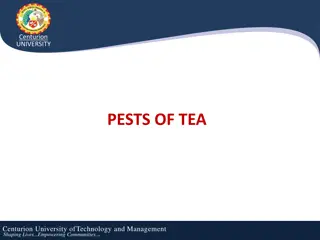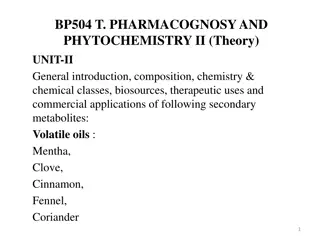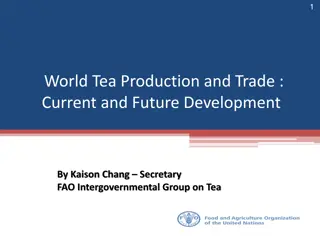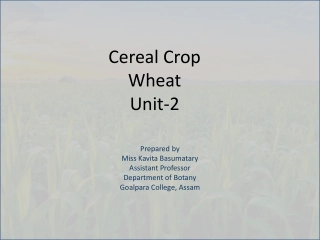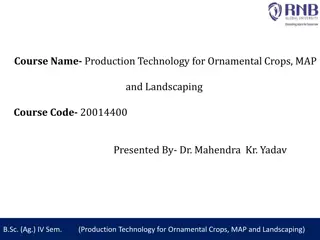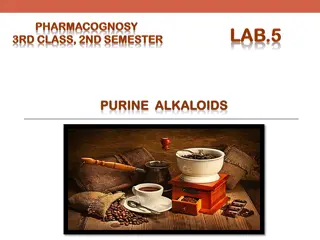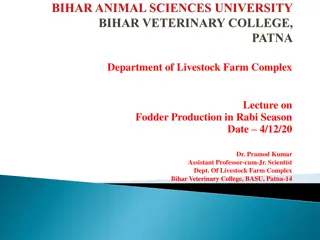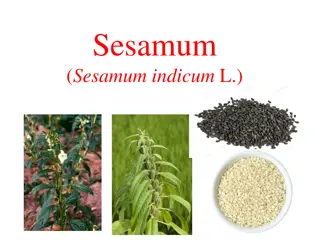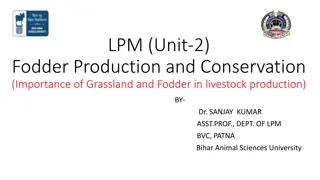Tea Cultivation in India: A Comprehensive Overview
Tea cultivation in India has a rich history dating back to 1823 when British settlers discovered wild tea plants in Assam. Today, India is the second-largest tea producer globally. Major tea-producing regions include Assam, West Bengal, Tamil Nadu, and Kerala. The ideal conditions for tea growth include a tropical climate, well-drained soils, and ample rainfall. The industry is overseen by the Tea Board of India and relies on labor-intensive practices for tea leaf plucking.
Download Presentation

Please find below an Image/Link to download the presentation.
The content on the website is provided AS IS for your information and personal use only. It may not be sold, licensed, or shared on other websites without obtaining consent from the author. Download presentation by click this link. If you encounter any issues during the download, it is possible that the publisher has removed the file from their server.
E N D
Presentation Transcript
S. Maheswari S. Maheswari Guest lecturer in Geography Guest lecturer in Geography Geography of India Geography of India 30.09.2020 30.09.2020 III B.Sc. Geography Topic : Tea in India
TEA IN INDIA TEA IN INDIA Tea plantation in India was started in 1823 when wild leaf plants were discovered by the British in the forest of Assam. Commercial production of tea was started by British East India Company. Maniram Dewan (1806-1858) was the first Indian tea planter and is credited with establishing commercial plantations of the Assamese variety of tea. Tea production, certification, exportation, and all other facets of the tea trade in India is controlled by the Tea Board of India. the first
India is ranked second among the largest tea producing countries in the world, next only to China. More than 70% of tea is consumed in The major tea-producing India are: Assam, West Bengal, Tamil Nadu, Kerala, Tripura, Arunachal Pradesh, Himachal Pradesh, Nagaland, Uttarakhand, Mizoram, Meghalaya, Bihar, Orissa. India itself. states in Karnataka, Sikkim, Manipur,
Conditions of Growth: Tea bush is a tropical and sub-tropical plant and thrives well in hot and humid climate. There is a very close relation between climate, the yield and the quality of tea. The ideal temperature for its growth is 20 -30 C and temperatures above 35 C and below 10 C are harmful for the bush. It requires 150-300 cm annual rainfall which should be well distributed throughout the year. While prolonged dry spell is harmful for tea, high humidity, heavy dew and morning fog favour rapid development of young leaves. Alternate waves of warm and cool winds are very helpful for tea leaves. Tea is a shade-loving plant and develops more vigorously when planted along with shady trees.
Tea bush grows well in well drained, deep, friable loams. However, virgin forest soils rich in humus and iron content are considered to be the best soils for tea plantations. Relatively large proportion of phosphorus and potash in the soil gives special flavour to tea as is the case in Darjeeling. In order to increase the yield, proper dose of nitrogenous fertilizers such as ammonium sulphate should be given to soil. Although tea requires heavy rainfall for its growth, stagnant water is injurious to its roots. It is, therefore, grown on hill slopes where water drains away easily and water-logging does not take place. However, it grows equally well in the valley if the drainage is good. Most of the tea plantations in India are found at elevations varying from 600 to 1,800 metres above sea level.
Tea is a labour intensive crop and requires abundant supply of cheap and skilled labour, especially at the time of plucking the tea leaves. This is a tedious process which requires skilled manipulation of fingers for plucking two leaves and a bud at a time. For this purpose, women labourers are employed in large numbers. Currently, tea industry provides employment to one million workers. Through its forward and backward linkages another 10 million people derive their livelihood from tea. It is one of the largest employers of women among organised industries of India. Women constitute over 50 per cent of the total workforce.
TEA PRODUCING STATES IN INDIA TEA PRODUCING STATES IN INDIA Assam Assam is the world s largest producer of tea. Assam produces almost half of total tea produced in India. The tea- producing region lies on either side of the Brahmaputra River. The daytime temperature rises to about 36 C, creating greenhouse-like conditions of extreme humidity and heat. This tropical climate contributes to Assam s unique malty taste, a feature for which this tea is well known. Assam Tea is a black tea named after the region of its production. Historically, Assam has been the second commercial tea production region after southern China. Southern China and Assam are the only two regions in the world with native tea plants. The main districts producing tea are Lakhimpur, Kamrup, Sivasagar, Goalpara, Cachar, Derrang and Nagaon.
West Bengal West Bengal state ranks next to Assam in the list of tea producing states in India. It accounts for more than 25 percent of the tea produced in India. The main districts producing tea are Darjeeling, Jalpaiguri and The Darjeeling tea is famous for its flavour and it is grown on the mountain slopes of the Himalayas at elevations ranging from 300 to 1800 meters. Coochbehar.
North India Himachal Pradesh (Kangra and Nandi districts) Uttarakhand (Dehra Dun district) Jharkhand (Ranchi district) Arunachal Pradesh Tripura Manipur Meghalaya
South India Tamil Nadu is the third largest producer of Tea in India. Tea is grown on the hilly slopes of the Nilgiris and Palais in the states of Tamil Nadu, The main districts producing Nadu: Kanyakumari, Tirunelveli, Nilgiris The main districts producing tea in Kerala: Cannanore, Palghat, Kozhikode, Malappuram, Quilon, Kottayam, Ernakulam, Idukki, Wayanad. Kerala s beautiful Hill Station Munnar, is the home of India s largest tea plantations. There are around 50+ tea estates in and around Munnar. Most of them belong to TATA Group. The main districts Karnataka: Chikmagalur, Coorg, Karnataka, and Kerala. Tamil tea in Coimbatore, Madurai, Trichur, Trivandrum, producing tea in




